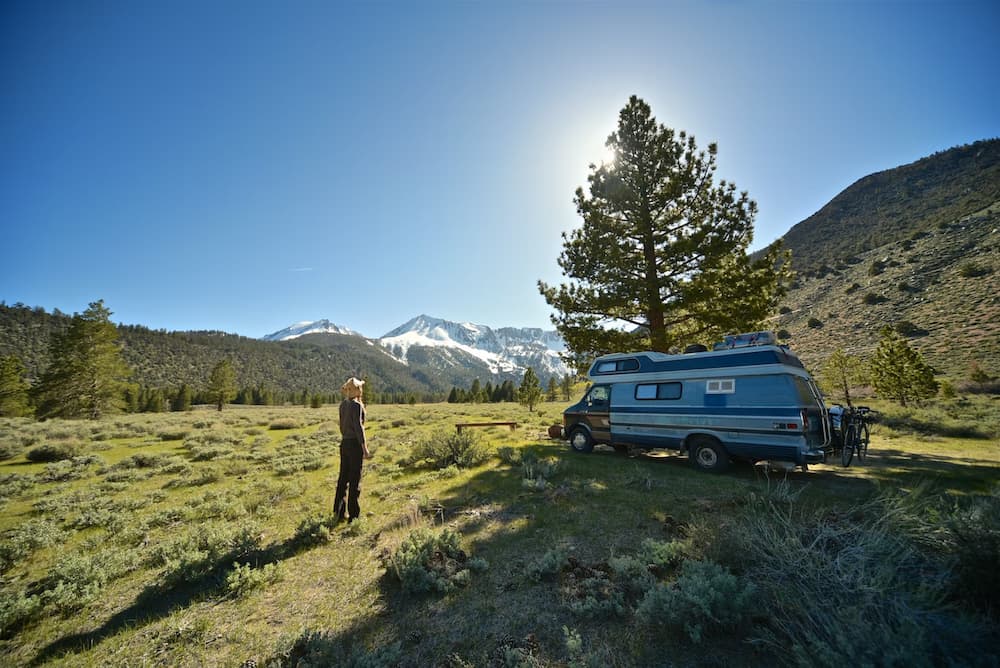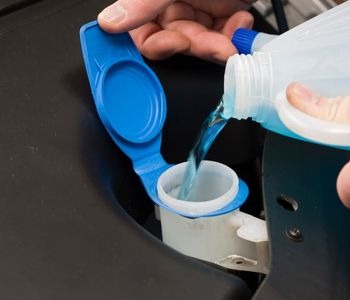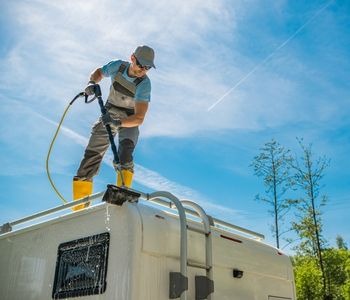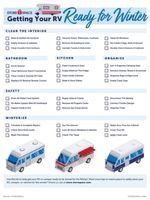How to Winterize Your Camper: Checklist and PDF

OK, it was an amazing camping season, but this is the time of year when everyone from first-time owners to seasoned veterans start asking how to winterize a camper.
Anyone can benefit from our free downloadable PDF checklist, which outlines the 14 most important steps to remember when winterizing your RV or camper. Then, once your camper is winterized, you can safely park it in storage until the weather warms up enough to start trekking again.
Our list covers the basics for most RVs and campers, but not all models, shapes and sizes. Your owner’s manual should have the steps outlined to follow, especially for the more complex processes around the plumbing and water supply systems.
This RV & Camper Winterization Checklist provides the perfect outline to help you organize and carry out all the tasks for winterizing.
It’s important to keep in mind what you’re hoping to accomplish during the winterization process.
- Prevent leaks and ruptures
- Prevent mold, mildew and rust
- Prevent rodent or insect infestation
- Prevent theft
How do you Winterize an RV?
Your owner’s manual should have a complete winterization checklist specific to your model. Many manufacturers also have downloadable owner’s manuals for back models online.
In addition to the handy tips below, YouTube is a great resource to find guided winterization tips, sometimes even for your specific model.
Clean the interior
Make sure you take the time to thoroughly clean your camper’s interior. This includes washing and sanitizing all the surfaces, such as walls, tables, floors, and doors of your RV or camper. This is important because even the smallest stains or crumbs can attract insects or rodents.
Don’t forget these steps:
What do to with these items: The items that are camper-specific, such as towels, sheets and so on should be washed and completely dried before being stored in an airtight container, think bins, totes, Sterilites or Action-Packers, until you’re ready to use them. Add cedar chips or dryer sheets to keep items fresh while stored.
Pro tip: label your camper totes and store them together so you can easily find and deploy them when RV season comes around again.
Remove all food
Since you’ll be emptying and defrosting the refrigerator and freezer, it makes sense to remove all food and water from those spaces. But it’s also important to remove other food items from your camper. This includes canned items that could rupture from a freeze (such as soda cans) or dried pasta/cereal/grains that might attract animals or insects. Don’t forget about spices and other cooking supplies.
What do to with these items: Anything that has an expiration date, you should try to use as soon as possible. Non-perishables (canned tuna, pasta, beans, rice and nut butter) can be stored in your pantry until next season, or if you suddenly come to the realization you’re never going to use four cases of ramen, consider donating those to a local food drive (or needy college student). Either way, don’t keep any food in your RV while it’s in storage.
Ensure everything is dry before closing up
This is a critical step in making sure your camper stays mold- and mildew-free during storage. Mold and mildew are fungi, which can grow on a damp surface in 24 to 48 hours. They thrive in dark and damp situations, especially where there’s little air circulation—sounds a lot like a parked camper to us. Mold can leave odors, discolor fabrics, leather and paper, and destroy some items.
As an additional safeguard, moisture absorbency packets are available for purchase at many storage facilities. They are not harmful to fabrics and in addition to working great in a storage unit, can help stave off moisture issues in RVs, too.
Read more about mold and mildew in this blog from the University of Missouri.
Empty and defrost the fridge
OK, we already mentioned this one, but we’ll reiterate it. Empty, clean and defrost the refrigerator. Food spills or condensation can attract pests, mold and mildew. When you’re done defrosting, towel-dry the interior and leave the door open just in case there were any moisture or other odor-causing agents left inside.
Drain water/add antifreeze

Drain all the water from the RV’s system, including water lines, holding tanks, hot water heaters, toilets and so on. Leaving water in the system could lead to many issues, such as busted pipes, broken faucets, mold issues or similar problems.
Once the water system is drained, fill with RV antifreeze (a.k.a. propylene glycol, available in auto parts stores and RV shops) to prevent freezing and protect seals throughout the system.
Inspect inside and out

Inspect the inside and outside of the camper/RV completely to ensure everything is sealed up. That includes windows, doors and hatches. If you find any bursting or cracking seams or holes, get them professionally repaired, or at least patch and fill until you can schedule a visit to the body shop.
Remove any propane tanks
This is especially important if storing on a self-storage property or RV lot, as it poses a safety hazard and violates lease agreements.
Disconnect the battery
Disconnecting the battery will help it last longer. If you’re storing at home or in a storage facility offering power, use a trickle charger to keep the battery fresh during the off-season.
Wash the exterior – dry before covering

Washing the exterior of your RV will serve a couple of purposes. First, it gets off dirt and other contaminants that might damage the vehicle over time, and second, it helps with your inspection.
Also, if you’re going to cover your RV (which we recommend), make sure everything is dry before putting the cover on, so as not to trap moisture that could lead to mold, mildew or even rust. As an alternative, wax the exterior of your RV, especially if you’re not planning on covering it.
Additional tips
Consider purchasing an RV cover and tire covers, especially if storing outdoors.
It’s also important to remember to lock your RV. Wheel locks are also acceptable at most storage facilities. If you’re using an RV cover, it should be locked and secured as well.
If you’re storing off your property, you need to make sure that your insurance and title/registration are up to date.
Make sure the wheels are inflated and in good shape, so they don’t go flat while the RV is stored.
RV Storage
Winterizing is only part of the process. The other consideration is storage. For some homeowners, there’s ample room on a driveway or side yard of their home to park an RV for months at a time.
For many others, though, a self-storage facility is the preferred way to go. Storage facilities often have advanced security features, rodent protection and specialized parking designated for oversized vehicles like RVs, trailers, campers and so on.
Want to learn more about the ins and outs of self-storage for RVs? Head over to our vehicle storage page or read up on camper storage tips to learn about the different types of storage available, amenities to keep your RV safe, FAQs, and additional preparation tips.
Then, use our storage location finder to locate the Store Space Self Storage nearest you. We care about Happy Campers like you!







